My Turbulent Homeschooling Journey
How a Loosey-Goosey Unschooling Mom Came to Embrace a Rigid Classical Education Style.
Recently, my eldest child, who is now 17, was accepted into the college that he applied to. His acceptance didn't surprise me. What surprised me was his decision to apply at all, because I never anticipated he would have any interest in attending college. Nonetheless, his admission brought a sense of joy. I've long considered my homeschooling efforts to be, well, less than adequate—indeed, deplorable. His college acceptance was like a soothing balm of relief, that maybe I didn’t completely mess things up.
In light of this milestone, I thought it might be enjoyable to spend some time reflecting on the past, and the lessons learned along the way.
Location: Georgia
Ages: I was 19 and my first child was an infant.
Circumstances: My husband was deployed for the first 15 months of our first child's life.
As a young and new mother, I was delving into various parenting books with curiosity. I read books like, "You Are Your Child's First Teacher," "The Baby Book," Margot Sutherland's "The Science of Parenting," all of Alfie Kohn's works, and John Taylor Gatto's "Dumbing Us Down." All of these books definitely helped shape both my parenting and educational philosophies, which all promoted a sense of “gentle” and “attachment” parenting, and child-directed learning, or “unschooling,” as opposed to traditional methods of education.
There was an online article titled something like, "What Your Four-Year-Old Needs to Know" that caught my attention. It was a tongue-in-cheek critique of school standards, listing playful activities essential for child development, such as jumping in puddles and collecting acorns, rather than academic achievements. This article really resonated with me, reinforcing my belief that education should nourish the heart and soul, not just the intellect, and that the child should be approached with love and gentleness, rather than forcing them to conform to strict and rigid rules.
Location: Okinawa, Japan
Ages: I was 21, my son was 2.
Circumstances: I was pregnant with baby #2, was living off-base in a foreign country, and was socially isolated by language barriers.
While living in Japan, my son was only two years old, so we hadn't started any official kind of schooling yet. During this time, I met a wonderful and quirky lady from a local knitting group who unschooled her three children. As we knitted together, I was consistently impressed and charmed by her children's brightness, humor, friendliness, responsibility, independence, and intelligence. I had read about unschooling in theory, but now I was able to see it in action. Observing these joyful and clever children solidified my belief that unschooling could be an effective approach to home education.
Although my son was not yet of school age, I had already begun to formulate some ideas for the future. Having been influenced in my childhood by the educational philosophy of Charlotte Mason, I was hoping to integrate her approach into our learning environment. Additionally, I was intrigued by the Montessori method and was considering incorporating aspects of it as well. But at the same time, the principles of unschooling appealed to me.
Consequently, I began to envision some kind of mixture of Charlotte Mason, Montessori, and unschooling methodologies for my homeschooling plan. This is where my veracious reading habit worked against me; I had exposed myself to so many ideas and methods of education, that I became indecisive about which path to follow.
My certainties were few, but I had some basic principles I wanted to uphold:
Purchasing a boxed curriculum was out of the question, as was following any traditional kind of curriculum.
I would never promote a competitive or pressure-driven learning atmosphere, thus I wouldn’t administer tests or give grades;
Coercing my child into learning through control, threats, or bribery would never be an option, thus I would never reward the good or punish the bad; I wanted them to be interiorly self-motived, not extrinsically motivated by outside influences.
I aspired for learning to be an enjoyable, playful, and joyful experience, ignited by innate curiosity.
Location: San Antonio, Texas
Ages: I was 24, children were 5, 3, and 1.
Circumstances: My daughter had been born with significant special needs which consumed our lives for 3 years, but now she was in stable condition.
As the time approached to begin Kindergarten with my oldest son, I opted for a blend of Montessori and Unschooling methods. I recall finding a PDF guide online about "implementing Montessori at home," or something along those lines. However, I was working within a very limited budget, so with virtually no funds available, I managed to cobble together a makeshift program using repurposed materials that we had around the house.
If you know anything about the Montessori method of education, then you already know that it cannot be haphazardly put together. But I wasn’t worried about it because I was thinking, "This is Kindergarten. It's not that important. At this age, learning is just for fun." At the time, I really had no true vision, goals, or any semblance of structure. I wanted to embrace an unschooling lifestyle where my son was able to direct his own education, and I would simply follow his lead as it unfolded.
Right after his 5th birthday, I wrote this in my journal:
"Three years ago, I knew I wanted to unschool and I knew I wanted to have a "free range" attitude towards my kids, but I felt a sense of anxiety about both of these things and wondered if I'd actually go through with it when the time came. Today I realized I am doing it. Our homeschooling so far has been incredibly lax and centered completely around Elijah's interests and his own personal drive. I base what we do, and how we do it, completely off of him, and so far, it's worked wonderfully. He is growing and thriving and learning with his natural curiosity and I have absolutely no worries about his education at this time. Unschooling is working for us so far."
In my journal, I documented a math lesson we had one morning. I recorded that, upon waking, my son was so enthusiastic about starting his math lesson that he skipped breakfast, preferring to dive right into schoolwork.
"I had him get his piggy bank out and we shook, shook, shook until a bunch of coins spilled everywhere, which we had to scoop up and keep away from the baby, much to the baby's dismay. We counted out 25 pennies and set them aside, then counted out another 10 and set them aside, and finally counted out another 5. We labeled them, "25 pennies," "10 pennies," and "5 pennies." We set a quarter, nickel and dime beside their corresponding piles and made "equal signs" for them to show that "25 pennies = 1 quarter," etc. After that, we played a trading game -- I gave him five pennies and he gave me a nickel in return, then I gave him 10 pennies and he gave me a dime in return, etc. I also had a worksheet prepared where he had to count out pennies and write the number in a box, and another worksheet where he had to determine the cost of items labeled with a coin value and draw circles representing how many pennies each item cost."
"After that, we worked on addition with marbles. I said, "Let's work on addition" and he said, "What? Like abra-cadabra stuff?" -- he thought I had said magician. :) When I was done laughing, I placed three small cups on the table. I had numbers written on small pieces of paper and had him choose two numbers (such as "2" and "3") and then he would put 2 marbles into one cup and 3 marbles into another cup & label each cup. Then we would combine them in the third cup to see how many they make together. He would count them and say, "2 and 3 together is 5." I also had him write out the equation "2 + 3 = 5" in a notebook. He took very well to the activities and was able to maintain concentration for an hour before finally starting to lose interest."
As evident from these pictures, we repurposed leftover food containers as cups, used marbles as counters, and a plastic blueberry container served as the marble box. Instead of a workbook, we simply utilized paper and pencil. Essentially, we made use of whatever materials were on hand around the house rather than buying anything.
Location: Washington State
Ages: I was 25, my children are 6, 4, and 2.
Circumstances: I have three little kids and my husband is deployed again.
When my eldest son turned six, we were residing in Washington state, with my other children aged four and two.
It became clear that my informal approach to Kindergarten had not led to any academic progress, and I finally acknowledged that a true Montessori education required a dedicated classroom and trained teachers. Consequently, I abandoned it and took an unexpected turn: I signed up for the Seton Home Study Program, ordering the complete first-grade curriculum for my son and the pre-K program for my daughter.
When the large box arrived, filled with fill-in-the-blank workbooks, I found myself implenting the very type of education I had wanted to avoid.
Those days are still clear in my memory. We resided in a duplex on the military base. I had lovingly added vibrant colors to the walls to counter the gloomy, gray, and rainy days of the PNW. The dining room wall was painted a cheerful peachy-orange.
At the table, we diligently worked through an array of workbooks: phonics, English, spelling, vocabulary, math, history, science... so many workbooks! In first grade, the expectation was for students to have started reading in kindergarten, but my son had not. He was also expected to write, but he couldn't. Completing "fill in the blank" answers is impractical when one cannot read or write. Nevertheless, I pushed him through the books, hoping he would learn how to read and write by repeated exposure. But still, by the year's end, he was not reading or writing.
My anxiety began to surface as I faced the reality of having a second grader who was not reading or writing yet.
The prevailing opinion among much of the homeschooling community seemed to be that the timing of learning to read or write is not important. They advised: "Don't worry about it; he will learn when he's ready. In the meantime, the best thing you can do for his education is read him a variety of high quality books. Just keep reading to him; that's the most important thing."
I endeavored to embrace this advice, but buried deep within was a profound sense of guilt and shame.
I continued with Seton's Kindergarten program for my daughter, hoping reading and writing would go better with her than it had with her brother. However, unknown to me at the time, she had a developmental delay. Although she was five years old physically, her mental age was closer to three. Nevertheless, she thoroughly enjoyed activities like cutting, pasting, coloring, and copying, which made her workbook exercises enjoyable for her. Ultimately, though, I was also unsuccessful in teaching her how to read.
While my daughter diligently worked on her Seton workbooks, I shifted focus with my eldest son. I guided him through popular homeschool curriculums, such as 'Handwriting Without Tears' and 'Explode the Code,' to work on his reading and writing. This approach yielded some success as he started to read basic words such as "cat" and "pig."
Simultaneously, I was unknowingly getting my first taste of Classical education. I found myself engrossed in Susan Wise Bauer's "Story of Civilization Volume 1" as I read it aloud to my son (borrowed from the library, I believe). With each chapter, I printed pictures related to our readings and affixed them to large poster boards. I annotated these visuals with dates, figures, locations, and events, creating a giant timeline that stretched the entire length of our hallway. It began with the Ancient Egyptians near the master bedroom and concluded with Ancient Rome by the children's bedrooms. Crafting this timeline was delightfully fun for me, although my son says now that he only vaguely remembers me doing this.
My son's aversion to school intensified over time. Following the lesson plans and maintaining a routine turned into a daily struggle. He wasn't absorbing the material, loathed narration to the point of refusal, and there were days he would end up lying on the floor in tears. I found myself wrestling with the purpose of homeschooling. Neither the loose, relaxed unschooling approach nor the rigid adherence to workbooks seemed to be working for us.
A friend of my mother's informed me that she had completed homeschooling and inquired if I was interested in having her books. Shortly after, a large box of books was delivered to my doorstep. The only three titles I can recall are: "Real Learning: Education in the Heart of the Home" by Elizabeth Foss, which is based on Charlotte Mason's philosophy; "A Little Way of Homeschooling" by Suzie Andres, which follows the unschooling philosophy; and "A Family Journal: A Homeschooling Mother's Companion" by Rita Munn.
"Real Learning" by Elizabeth Foss profoundly influenced my approach to homeschooling. I had been a long-time reader and admirer of Elizabeth’s blog. It served as a source of support and inspiration during my early years of motherhood. Elizabeth's exceptional writing added charm and beauty to her work, and her book offered a lovely vision of home education. I was inspired to emulate that beauty in my own home, and I wanted to begin immediately. It was time for Charlotte Mason.
Location: Still in Washington
Ages: I was 27, my oldest son was 8 (3rd grade), my daughter was 6 (1st grade), and my youngest son was 4 (preK).
Circumstances: Pregnant with baby #4.
I have to share that around this time my oldest son had a pleasant surprise for us. After tucking the children into bed, my husband and I settled into our usual routine of reading on the couch. As we were engrossed in our books, our 8-year-old son emerged from his room, book in hand, declaring, "I finished it." My husband and I exchanged puzzled looks. "But you can't read," I blurted out. I took the book from him and skeptically asked, "How did it end?" as I scanned the final chapter. He recounted the last chapter's events in detail. And just like that he could read, and he understood what he was reading.
As my 8-year-old progressed into the 3rd grade, I apparently decided to blend Charlotte Mason's approach with Seton's workbooks.
My lesson plan for that year included using Seton's textbooks for Math and Language Arts (Phonics, Handwriting, and English), while employing living books for Religion, History, Science; and placing a strong focus on Literature and Nature Study. I allocated only 10 minutes for each workbook session, aligning with the Charlotte Mason philosophy of brief lessons.
Interestingly, for my daughter entering the 1st grade, I adopted the Charlotte Mason method fully by removing all workbooks from her curriculum, as I noted in my lesson plans: "In line with Charlotte Mason's philosophy for early education, textbooks will not be used." My ambitious agenda for her included subjects like religion, language arts, math, history, literature, geography, poetry memorization, picture study, music appreciation, and art. Additionally, I planned for rainy day nature walks followed by hot tea at home while exploring the works of renowned artists and composers.
Sadly, within a mere two months, my homeschooling endeavors seemed to unravel swiftly. I had devoted immense time and energy to craft a meaningful educational experience for my children, honoring their unique learning styles and ensuring to include all the fundamentals of a rich education. But concurrently, I was juggling the care of a new baby, household responsibilities, meal planning, grocery shopping, daily Mass attendance, managing my daughter's special needs, engaging in playdates and bible studies, and adjusting to a newly adopted dog, among other things. Ultimately, the cumulative burden overwhelmed my fragile mental health, leading to a breakdown.
Mysteriously, my journal recounts a visit with a friend, whom at this time I have no memory of. But I wrote that I went to her house for coffee and a chat:
"I drank up a lot more than just coffee. I seeped in her words of experience and took them to heart. I went home and threw away our schedule that I had spent so much time and effort creating, and I tossed half our books that I had spent so much money on."
Two months later, I enrolled my two oldest children in public school.
I was devastated:
"I don't want this, but I don't see an alternative. I have determined where I am in life, and it's a place I don't like and don't want to be. I'm striving for the place I want to be, but in the meantime, this is where I am. I have to accept that, I have to understand my own limitations, no matter how much I wish they weren't there."
In the following pages, I describe how I drove myself to the emergency room, crying the whole way. When I arrived, I hesitantly informed the nurse, "I'm suffering from depression and fear I might harm myself." The hospital staff was incredibly compassionate and supportive. They suggested a two-week admission, but I declined due to my breastfeeding baby at home, fearing that switching to formula would worsen my depression. Instead, I returned home with medication and an appointment with a counselor. I was terrified to start the medication, taking the first dose with trepidation. Yet, I understood the necessity to keep living.
Gradually, the medication began to take effect. I found myself able to get out of bed, shower, and dress again. I resumed cooking meals and caring for my family. With each passing day, I noticed improvements. However, the side effects, which included persistent headaches and fatigue, made tending to my duties difficult. The children stayed in public school on the military base for several months, until we moved off the base.
Location: Still in Washington
Ages: I'm 28, my children are 9, 7, 5, and the baby is 1.
Circumstances: My husband was medically retired from the military, thus ending our military life, and we moved into a small, dilapidated rental house in a bad neighborhood.
One day during Mass, my baby was fussy. I stepped outside and started pacing the sidewalk. The century-old brick church was nestled in a neighborhood of old homes,a neighborhood I longed to live in so I could be within walking distance of my beloved church building. As I strolled, I gazed at each one and contemplated, "Will we ever settle near the church as we want? Does God intend this for us? Would it truly benefit our family as we believe it would?" I mulled over these thoughts, examining each home—some well-maintained, others in disrepair— and I harbored a fervent hope that we might find one to call home, should it align with God's plan for us.
Little did I know that within six months, those hopes would materialize as we found a rental home in the neighborhood.
However, it was far from the dream I had envisioned.
The house was 87 years old, situated very close to our church. It had three bedrooms, was pet-friendly, and the rent fell within our budget. It had charm and curb appeal. However, it was in a state of neglect. Neither the previous tenants nor the landlord had maintained it very well. Numerous things were in disrepair, including windows and floorboards, and the landlord was notoriously slow to address issues. There were cracked tiles, absent light fixtures, doors that wouldn't shut, and bathroom mirrors so distorted they obscured one's reflection. Yet, the most concerning issue was the home's location in a bad neighborhood. My sense of security was compromised, especially with my husband working night shifts, leading me to keep a loaded gun under my pillow at night for safety.
But an extension had been added to the house, which made for an ideal school room. I arranged our bookshelves, stocked them with books, and placed a large table at the center of the room. My memory of our schooling during this period is pretty hazy. The only clear memories I have are of serving treats and cups of tea while reading poems and literature out loud.
Our stay in the rental was brief. It wasn't long before we purchased our first house, and it was after this move that I returned to the concept of Unschooling.
In a journal entry at that time, I reflected on my initial intentions with homeschooling and how far I had strayed from them. I had given in to pressure and bought a curriculum out of fear, only to abandon it later due to its overwhelming demands. Subsequently, I adopted the Charlotte Mason philosophy, which also fell apart.
I expressed distress over this pattern of changing methods, acquiring new books, and experimenting with various curricula. Throughout this time, I was descending deeper into a state of depression, anxiety, and paranoia, and I was plagued by persistent feelings of stress and guilt.
I wrote:
"I didn't want this for my children or for myself. This isn't the family or life I envisioned having, and I am not being the mother I want to be. I am not even living according to my own values and beliefs. Putting the children in school is not a good alternative, and none of the advice I have received from others seems right for my family."
I made the decision to embrace Unschooling in its most radical form. I ceased attempting to direct their education, instead allowing them to explore whatever genuinely brought them joy. For a while, I simply watched my children and took notes. My aim was to discern their deepest interests by observing their natural inclinations when they had no obligations. During this period, I catered to their desires. They participated in swimming, piano, archery, chess lessons, and day camps at the zoo. We frequently went bowling, roller-skating, visited farms and toured factories, took art and cooking classes, and joined a local birding group.
I was eager to provide them with a broad range of experiences, hoping some intense passion would ignite within them.
Yet, after many months, I began to feel concerned because they still lacked any real direction. They were always reading books (and listening to audiobooks) and were constantly immersed in imaginative play, but they hadn't taken hold of a passion that I could follow. Other unschoolers that I knew were following their child's lead and getting involved in some amazing things, but my children were not giving me any leads to follow. I didn't know what to do with them, and doing nothing was inducing guilt:
Homeschooling has been nagging at me again. Since I decided to stop homeschooling several months ago, there has been a despair and hopelessness trying to engulf me. I feel it creeping up, I feel it surrounding me, and I try my best to keep it at bay. I don't think there is anything I can do to stop myself from worrying.
Location: Still in Washington (2017-2018)
Ages: I'm 29, my children are 10, 8, 6, and 2.
Circumstances: I decide to put my children back in a school, and soon I will be pregnant with twins.
My mental health challenges were becoming substantial, and it was evident that I needed help. Once I had the humility to admit that and to embrace the possibility of enrolling the kids in a school, it was then that we discovered a small, private school only two miles from our new home, previously unknown to us.
In an unexpected turn of events, my husband and I chose to enroll our children in this small school, despite the fact that it was Sedevacantist and we were not. While some of our friends openly opposed our decision, most understood our choice and supported us. Our priest even offered his approval, telling us, however, not to partake in their sacraments.
At the time, there appeared to be three paths available to me:
Secular and worldly education provided by the government (public school)
Diluted, minimally Catholic education reflecting the new order (diocesan Catholic school)
Firmly traditional Catholic education, adhering to pre-Vatican II principles with daily Latin Mass (sedevacantist school)
From a financial perspective, it was the most economical option. In terms of practicality, it was the nearest to our home. In alignment with our religious beliefs, it mostly matched. Personally, the small class sizes and familial atmosphere resonated with my values.
Yet, I still had reservations and concerns. I wondered how my children would adapt to a structured and textbook-intensive curriculum, how they would handle the early mornings, uniform dress code, adherence to teacher instructions, rote learning for exams, scheduled meals, and the lack of freedom. Nevertheless, these worries did not outweigh the necessity to put them in school. Considering my mental health struggles and the shortcomings of our homeschooling, something had to be done, and this was the solution I was willing to pursue.
Eight months after enrolling them in the school, I wrote this in my journal:
"My children not only adjusted easily but thrived in their new school environment. They love their teachers, they love their schoolwork, and they love their friends. They have been so happy, and I have witnessed not only amazing academic progress, but a real growth in their spiritual lives as well. We walked in with a sense of trepidation, but every concern I had has flown out the window. This has been the perfect fit for our family.
In the past eight months, my children have become more obedient, more polite, more responsible, more self-disciplined, made progress in their school studies, and grown spiritually. I never imagined my children would be coming home from school with awards for leading their class in good conduct, or that my daughter would come home dreaming of becoming a nun because of the positive influence of her teacher.
I have been nothing but impressed with the sisters' teaching, but also with my children's receptivity. My children are not only receiving the information, but they are responding to it in a very real and perceptible way. Having the help of the sisters at the school to guide and teach my children along with me has been literally life-saving."
The children attended this school for two years before we moved again.
I can honestly say that I have no criticisms or complaints; the entire experience was delightful for all of us. Having been predisposed to the notion that homeschooling was invariably the “better choice,” it was a humbling revelation to discover that traditional schooling can be a wonderful experience when executed properly.
It also became clear that my preconceived beliefs about parenting and education were not entirely correct. Children can flourish in remarkable ways when encouraged to tackle and learn challenging subjects that may initially seem unappealing.
The whole experience altered my perspective on education.
Location: Idaho (2019-2020)
Ages: I'm 32, the kids are 12, 10, 8, 4, & 1-year-old twins.
Circumstances: It was never our intention to live in Washington as long as we did, at some point we realized we needed to move home to Idaho. It was a very hard decision to make because we loved our friends, our church, and our school very much.
Upon arriving in Idaho in October, I resumed homeschooling. My mental health had significantly improved compared to two years prior, and I approached it with confidence. I intended to maintain simplicity, choosing to use the same books as the school, and I committed to not add any more resources.
What I couldn't have anticipated was the overwhelming mental breakdown that was looming. I'm not certain what exactly triggered it, but I suspect it was a mix of these factors: the turmoil of a big move, the abrupt loss of my entire support network (friends, church, and school), returning to homeschooling, and the stress of caring for twin babies.
It only took a month before I was planning my death. But thankfully, I had the presence of mind to go to the emergency room again. I can vividly recall that morning. The twins' favorite breakfast was oatmeal, so I prepared it as I did every day. I set the bowl in front of my 18-month-old son. He glanced at me, then at the bowl, and proceeded to overturn it onto the floor. That was the moment I snapped. Trembling, I took my keys and exited the house. I headed to the E.R., and this time, I allowed them to admit me.
Upon my release, enrolling my children in a local diocesan school was one of the first steps I took. There were no other options available. We enrolled the kids in 7th, 4th, 2nd and PreK. We weren't entirely pleased with the school (it definitely fell short of our previous experience). However, not everything about it was negative, and it was a preferable option to homeschooling. Plus, the headmaster was trying to overhaul the school and introduce a Classical education. Although he was facing some opposition from parents and the diocese, we saw improvements being made while our children were attending, and we were hopeful about the future of the school under his direction.
Then, just three months later, COVID struck. Schools shut down in March, and the children returned home. Since schooling had halted globally, I didn't feel guilty about not conducting school at home for the rest of that academic year.
But when the fall of 2020 rolled around, I knew I had to do something.
The good headmaster had been fired from the school, so we didn't want to put our children back in. We spent that year sitting on the couch together, reading many lovely books and simply discussing them. Whatever else we may have done, I don't remember. I only remember reading.
2021 - Current
And so, we arrive at the next and final chapter of this memoir.
In 2021, with the children aged 14, 12, 10, 6, and 3 (the twins), we joined TAN Academy. I was apprehensive about homeschooling, expressing to my husband my doubts and fears for my mental health, so he decided to primarily educate the three eldest, allowing me to focus on the youngest three.
Lacking confidence in myself, I decided to adhere strictly to the provided lesson plans and use all the suggested books without any modifications. This turned out to be the most rewarding homeschooling experience I've ever had. It was especially effective for my first grader, whom I taught to read using Logic of English. It was the easiest experience I ever had teaching a child to read and write. The entire year progressed with surprising ease, and believe it or not, so did the second year.
Concerning my eldest son specifically, he started the TAN Academy Lesson Plans in his freshman year of high school, with my husband taking charge of his education. He followed the lesson plans as they were written (which were straightforward and easy to follow). His subjects included Theology, Literature, History, Science, Math, Logic, and Latin. He simply followed the daily syllabus, and at each day's end, my husband would review his work. They maintained this routine for three years. Following the 11th grade, my husband concluded that further high school education was unnecessary. In Idaho, the law regards homeschoolers as school administrators, allowing them to legally graduate their children once they reach the age of 16 and meet the requirements. We issued him a diploma and prepared his transcripts.
Our son then chose to pursue a degree in criminal justice, so he applied with his transcripts and was admitted. He completed placement exams in Math and English, passing both effortlessly.
I am glad that, despite his tumultuous educational journey over the past 13 years, it did not hinder his ability to learn what was necessary for college acceptance, since that is the route he decided to take.
Currently, I would say that there are three significant influences on my approach to homeschooling: the TAN lesson plans, the Well-Trained Mind, and Charlotte Mason.
TAN
Four years ago, when we first adopted the TAN lesson plans, they provided the structure I desperately needed. My homeschooling journey had been chaotic and filled with so many mistakes, as I failed to provide the education I envisioned for my children. As a result, I carried with me intense guilt and a sense of failure for years. The TAN Lesson Plans were the perfect solution at the time, offering a book list and daily instructions, so that all I had to do was follow the plan that they laid out. The initial year of implementing these lesson plans marked the most successful teaching experience I've ever had.
After a couple years of using the lesson plans, we've identified our preferences and what works for us, which has led us to modify the lesson plans to suit our family. For instance, even though I think Saxon is a great math program, we opt to transition our children from Saxon to Teaching Textbooks around the 4th grade.
The Well-Trained Mind
One day, during a visit to the library, I perused the homeschooling books and came across 'The Well-Trained Mind': A Guide to Classical Education at Home' by Susan Wise Bauer and I decided to borrow it.
While reading the book, I found that it resonated with me profoundly. What is and is not a "Classical Education" is often debated (and it's a debate I'm not qualified to weigh in on), but it was clear to me that the Classical method as presented by The Well-Trained Mind was within my capabilities. In fact, I was already implementing a lot of it, but the book helped bridge some gaps I was missing and clarify things. Thus, I started to apply even more of the classical method into my homeschooling and saw positive results right away. I found myself conducting narration, picture study, and poetry memorization with my children—something I had tried to do before, but had never managed to implement effectively. While it's too late to change the informal education I provided to my three oldest, it is not too late to make improvements moving forward with my next group of students.
Charlotte Mason
Charlotte Mason also continues to influence how I approach home education. My familiarity with her methods comes from personal experience: my mother implemented the Charlotte Mason method for several years when she homeschooled me. I don't think of myself as a "CM Homeschooler" at all, but I do like and respect the method. I think it’s because there are many shared concepts between the CM philosophy and the Classical approach. Due to these overlaps, I do frequently visit CM websites for guidance, particularly for their excellent book recommendations.
Here are some of the elements shared by Classical Education and Charlotte Mason education:
Narration, copy work, and dictation are fundamental.
Charlotte Mason's "Habit Training" aligns with the Classical education's aim of cultivating wisdom and virtue.
Self-discipline is a requirement
Cultivating the habit of paying attention.
A commitment to high-quality literature is central.
Engagement with profound and noble ideas.
To produce students who can find and analyze information, think critically about that information, and articulate their thoughts and ideas.
Appreciation of fine art, including picture study and the memorization of poetry.
Conclusion
I've read literally dozens of books about homeschooling over the years, and I've tried just about every method out there, but this is what I've settled into that aligns with my hopes for my children's education and is actually feasible for me to apply practically.
However, the fact remains that homeschooling is a choice—that is, I could enroll my children in a school— and so I pondered whether this is truly a cross Christ intends for me to carry, or have I inadvertently burdened myself with a cross of my own making, one He never meant for me to shoulder?
That question remains on my heart as I know, deep down, what I want is for my children to be in a school. Once upon a time, I was convinced that to put a child in a school was one of the worst things you could do for them, and that homeschooling was simply the best thing, both from a natural and supernatural point of view. That is no longer my opinion.
I think school can be a wonderful option. Not all schools are evil, or have an evil agenda. It can be a good thing for children to learn order, discipline, self-control and obedience in a classroom environment.
Some people think it’s wrong to force children to go to school, to do things they don’t want to do, wear the same uniform every day, have to obey authority, and to respond to ringing bells. They say it destroys their individuality and creativity. But if you ask me, it sounds like a thoroughly Catholic idea— one that could even effectively train them to generously accept the call to the religious life, where they will have to submit to the authority of a superior, live according to a disciplined Rule, wear the same habit every day, and respond to the ringing of bells that call them to prayer.





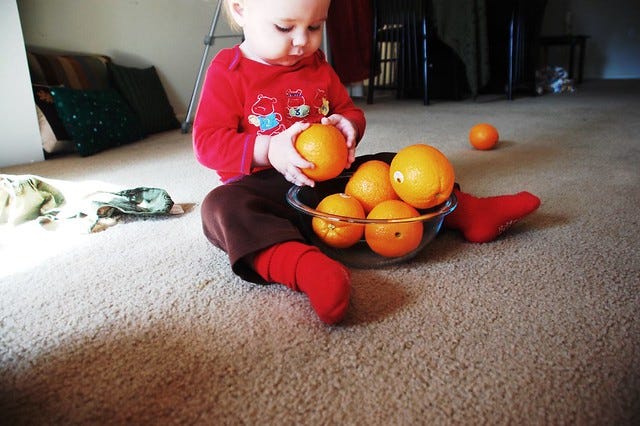

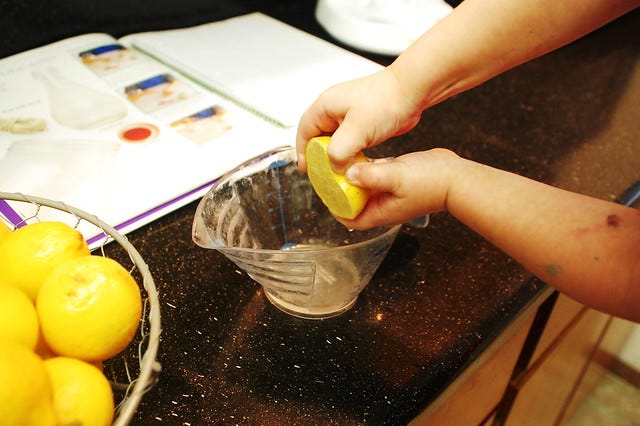
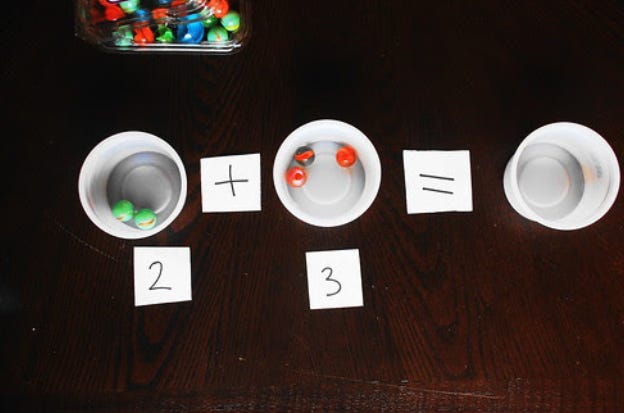

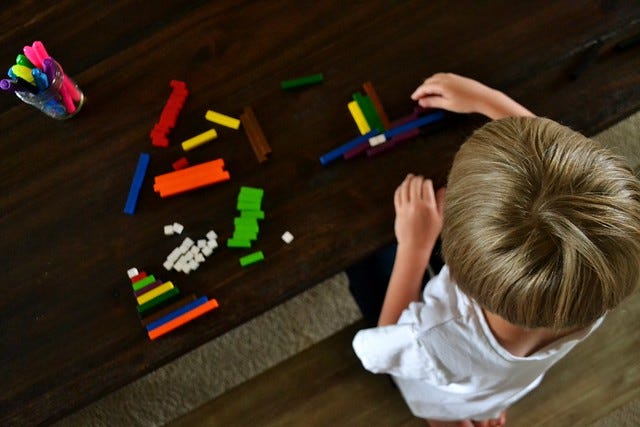

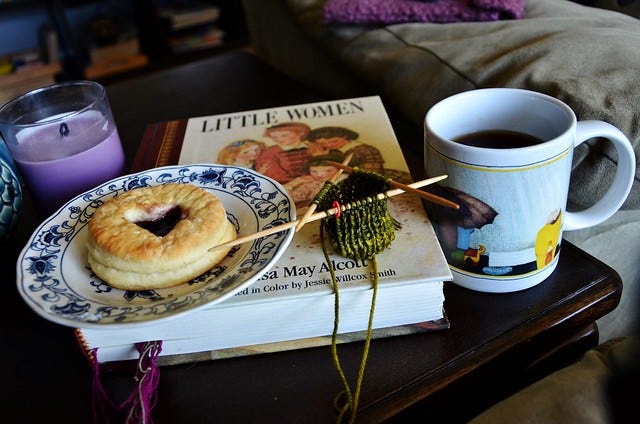
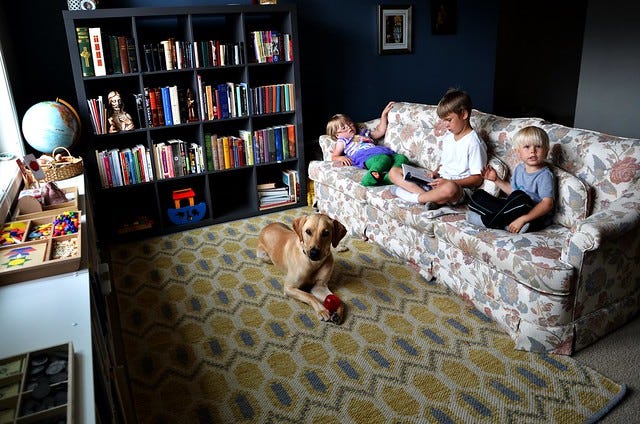
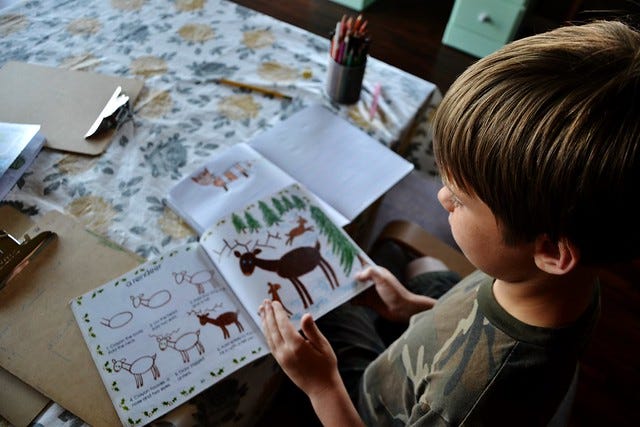
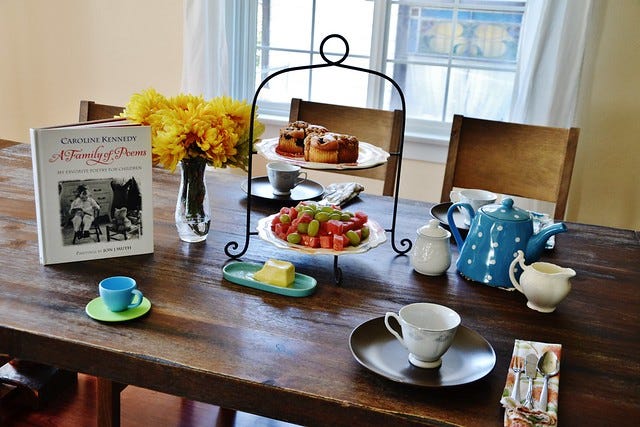
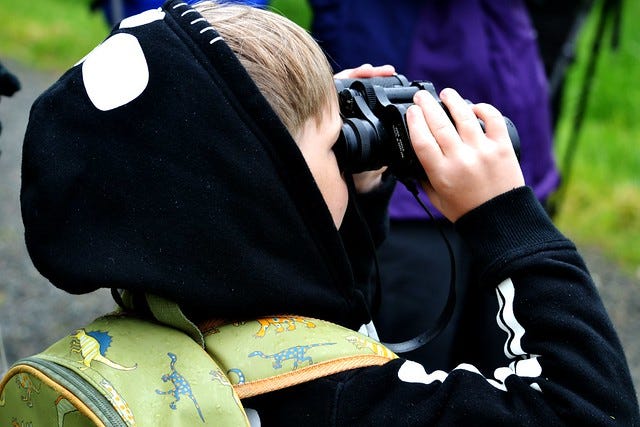
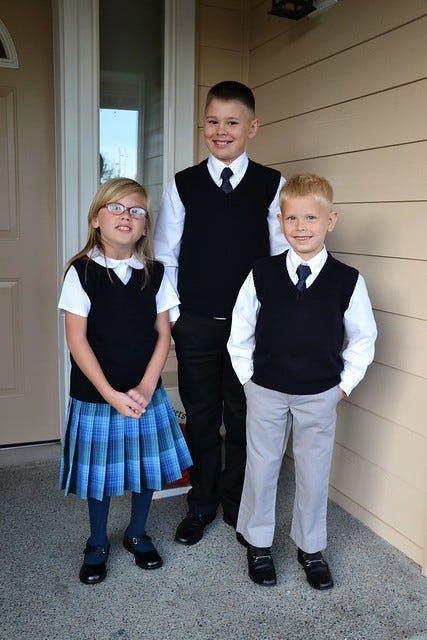

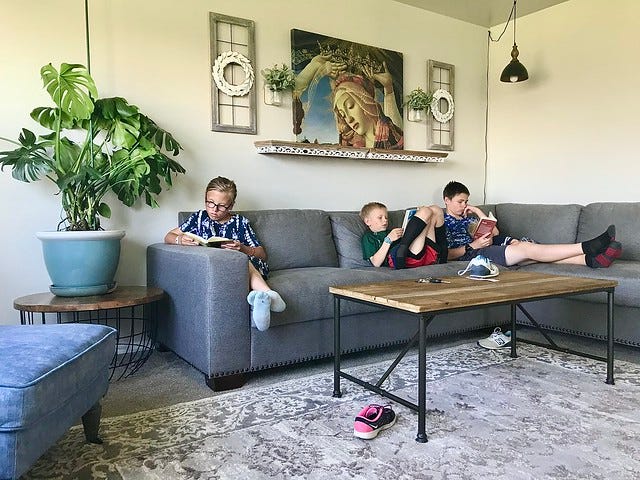

I see a lot of parallels in here to my home-schooling journey. I'm very eccentric - doing some Charlotte Mason, some classical, some unschooling. We have 8 children and 4 have graduated from our homeschool. The oldest 2 still in school are attending a local guild, which does a combination of humanities, math and science, and I absolutely love it! They meet 2 days a week and the tuition is affordable to us (with my husband being the sole breadwinner). I just have my 2 youngest at home and am still figuring out - beyond the tons of reading, art, cooking, playing, etc. that they are currently doing - what else to do more formally. I also struggle with my mental health - anxiety and depression, PTSD, an OCD diagnosis. Sometimes I think it's a wonder that I'm still breathing, blinking, and my brain is still making waves. I told a former therapist that I was afraid I'd have a nervous breakdown, and he said, "I don't think you're capable." I have to laugh about that. Anyhow, I've got to get back to duties here. Have a Happy Thanksgiving!